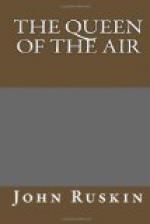141. But if the reader can give due vitality in his fancy to these two scenes, he will have in them representative types, clear enough for all future purpose, of the several agencies of debased and perfect art. And the interval may easily and continuously be filled by mediate gradations. Between the entirely immodeset, unmeasured, and (in evil sense) unmannered, execution with the fist; and the entirely modest, measured, and (in the noblest sense) mannered, or moral’d execution with the finger; between the impatient and unpractised doing, containing in itself the witness of lasting impatience and idleness through all previous life, and the patient and practised doing, containing in itself the witness of self-restraint and unwearied toil through all previous life; between the expressed subject and sentiment of home violation, and the expressed subject and sentiment of home love; between the sympathy of audience, given in irreverent and contemptuous rage, joyless as the rabidness of a dog, and the sympathy of audience given in an almost appalled humility of intense, rapturous, and yet entirely reasoning and reasonable pleasure; between these two limits of octave, the reader will find he can class, according to its modesty, usefulness and grace, or becomingness, all other musical art. For although purity of purpose and fineness of execution by no means go together, degree to degree (since fine, and indeed all but the finest, work is often spent in the most wanton purpose —as in all our modern opera—and the rudest execution is again often joined with purest purpose, as in a mother’s song to her child), still the entire accomplishment of music is only in the union of both. For the difference between that “all but” finest and “finest” is an infinite one; and besides this, however the power of the performer, once attained, may be afterwards misdirected, in slavery to popular passion or childishness, and spend itself, at its sweetest, in idle melodies, cold and ephemeral (like Michael Angelo’s snow statue in the other art), or else in vicious difficulty and miserable noise—crackling of thorns under the pot of public sensuality—still, the attainment of this power, and the maintenance of it, involve always in the executant some virtue or courage of high kind; the understanding of which, and of the difference between the discipline which develops it and the disorderly efforts of the amateur, it will be one of our first businesses to estimate rightly. And though not indeed by degree to degree, yet in essential relation (as of winds to waves, the one being always the true cause of the other, though they are not necessarily of equal force at the same time,) we shall find vice in its varieties, with art-failure,—and virtue in its varieties, with art-success,—fall and rise together; the peasant-girl’s song at her spinning-wheel, the peasant laborer’s “to the oaks and rills,”—domestic music, feebly yet sensitively skilful,—music for the multitude,




